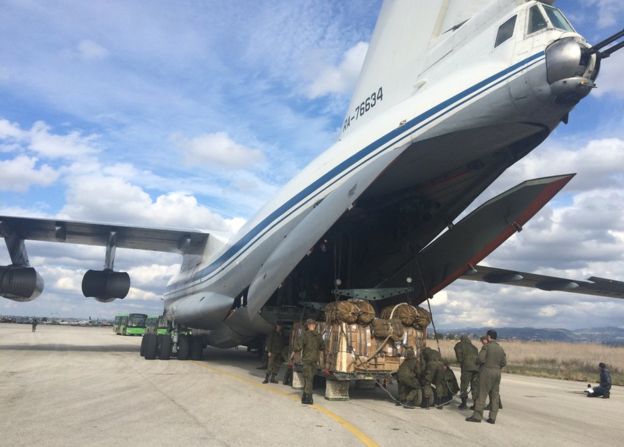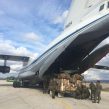
Rebranding Russia’s Military Operations in Syria
Publication: Eurasia Daily Monitor Volume: 13 Issue: 56
By:

President Vladimir Putin has created a storm of speculation concerning his decision to wind down Russian operations in Syria by announcing that a withdrawal would commence on March 15, involving the “main group” of forces (see EDM, March 15, 17, 21). Reaction in the Russian media was favorable, while much reporting centered on what seemed to be a relatively successful campaign. According to Viktor Ozerov, the head of the defense and security committee of the Federation Council (Russia’s upper chamber of parliament), air defense systems will stay in place in Syria to cover Russian military facilities, the main body of troops is to be withdrawn, while the naval group in the Mediterranean Sea will remain in place (Nezavisimoye Voyennoye Obozreniye, March 18; Krasnaya Zvezda, The Moscow Times, March 15).
On March 16, Dmitry Peskov, the presidential press secretary, confirmed that Russia’s military facilities in Syria will continue to be protected by “land, sea and air,” as Putin had instructed, but the Kremlin spokesman quibbled on the issue of referring to Tartus or the airbase at Latakia as “bases.” Technically, Peskov is correct, at least about Tartus. The Latakia facility is covered by a standard basing agreement that appears consistent with Russian airbases abroad. However, the Tartus facility is certainly not a naval base, and to characterize it as such would be entirely mistaken. Tartus serves as a Material-Technical Support Point (Punkt Material’no-Tekhnicheskogo Obespecheniya—PMTO). In other words, the depot at Tartus functions as a logistical hub for the Russian naval group in the Mediterranean Sea, which serves as a better option than returning to base for repair and maintenance. It also acts as a hub in the Russian supply lines to Syria, both for the transfer of weapons and equipment to the Syrian regime, support for the Russian operations that began in September 2015, and ongoing support for the military facilities, including the airbase at Latakia (RIA Novosti, March 16; Interfax, October 14, 2015).
Conflicting Russian media reports and confused Western coverage differed on the speed of withdrawing strike aircraft, with the Pentagon reportedly assessing that most strike platforms had been removed by March 19. Nonetheless, the Russian defense ministry continued to confirm the Aerospace Forces’ (Vozdushno Kosmicheskikh Sil—VKS) involvement in close air support (CAS) missions around Palmyra to aid the Syrian Arab Army (SAA) in its ground offensives. Indeed, the VKS may well have pulled some high-profile assets from Latakia, but it also inserted other sophisticated platforms, such as the Mi-28N and Ka-52 helicopters—though these are being deployed in small numbers rather than to “replace” other assets (Livejournal, March 17). The appearance of the new generation helicopter assets is consistent with Russia’s propensity to carry out combat testing of advanced systems during the Syrian intervention. The overall cost of the operation to date stands at $460 million (TASS, March 17).
During a ceremony to decorate service personnel for the operation in Syria, Putin said the number of sorties had declined by two thirds and noted that operations against the Islamic State (IS) and al-Nusra would endure in support of the SAA (Kremlin.ru, March 17). The General Staff confirmed, on March 18, that the VKS delivers strikes against various targets, making around 20–25 daily sorties in support of SAA operations in Palmyra. Lieutenant-General Sergey Rudskoy, the chief of the main operations department of the Russian General Staff, said, “A large-scale operation to free the city of Palmyra has been carried out recently by government forces and patriotic forces with support from Russia’s Aerospace Forces,” adding, “Conditions have been created for encircling and routing the armed units of ISIS [the Islamic State of Iraq and Syria—former name for the IS] in Palmyra.” Rudskoy also explained that operations against the IS and al-Nusra would, indeed, continue (TASS, March 18).
While Rudskoy stated that some operations would persist in support of the SAA, he also stressed that assets were being withdrawn by sea. He noted that the VKS’s commander-in-chief, Colonel-General Viktor Bondarev, had asserted completion of withdrawing the main part of the strike group: Su-24Ms, Su-25s and Su-34s. When the process is finished, the airbase at Latakia will still have some Su-24 bombers and Mi-24 and Mi-35 attack helicopters, as well as Su-30SM and Su-35 multirole fighters (Vedomosti, March 16). Rudskoy commented on the use of air and sea routes to complete the task of moving the main part of the forces out of Syria: “Part of [the] equipment and cargoes will be transported by planes of Military Transport Aviation, another part—by ship transport” (TASS, March 18). In Turkey, local observers of Russian ship movements along what is termed the “Syrian Express” noted no surge in northbound traffic. On March 20, the Black Sea Fleet’s Dvinitsa-50 cargo ship was the first moving north since Putin’s announcement—returning empty to its base in the Black Sea (YouTube, March 20).
The question of withdrawing the main group for Syria remains clouded in mystery, with sources close to the Russian defense ministry saying that the “first stage” will involve a 50 percent reduction to around 30 fixed-wing and helicopter air assets staying in Syria for an indeterminate period. Colonel (retired) Viktor Murakhovsky, the editor of Arsenal Otechestva, sees the key result of the operation as the defense and expansion of regime-controlled territory, which will allow the SAA time to prepare fresh offensives. But Murakhovsky was elusive on the precise meaning of Putin’s withdrawal (Vedomosti, March 15).
Vasily Kashin, a leading researcher at the Institute of Far Eastern Studies, sees Putin’s announcement in terms of marking the beginning of a new phase; in effect the first phase of the initial operation is actually over. This will mark a new and much longer campaign. Putin’s plan is to reduce the “main part” of the strike group, but the target numbers set to remain have not been disclosed. A large part of it will likely stay in place at Latakia, as will the Tartus PMTO, as well as the naval group in the Mediterranean Sea. The latter was first assembled in 2011–2012, during the early stages of the conflict in Syria, and has since been reinforced. This drives the underlying requirement for maintaining air defenses (RBK, March 16).
It appears that VKS operations will continue, albeit in a muted form and probably couched in terms of the details of the cessation of hostilities agreement that allows pursuit of the IS and al-Nusra. This longer phase of the VKS operation is likely to be portrayed as a response to other parties violating the present “ceasefire” terms.




